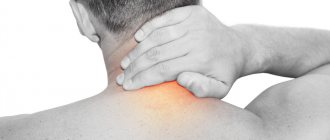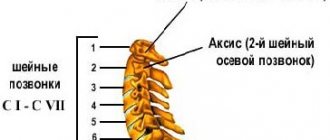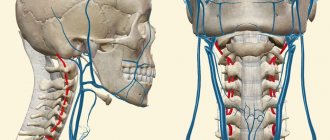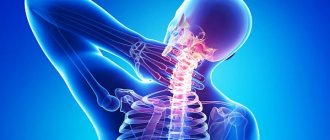Why does neck pain occur?
Neck pain is an unpleasant sensation. Millions of people face this problem throughout their lives. Age does not matter. Children and adults are equally at risk of developing this disease, which worsens the condition, affects overall well-being and often forces them to change plans, disrupting their usual way of life. In most cases, short-term pain is not a symptom of any disease and goes away within a few days. The cause of short-term pain is most often sitting at a table for a long time or an uncomfortable posture during sleep. As a result of these actions, the muscles become overstrained, which leads to pain in the cervical region.
Sudden movements, intense physical activity, and sports exercises that are performed without warming up the muscles can also cause neck pain. This occurs due to stretching or damage to muscle fibers. In particularly difficult cases, neck pain may not be aching, but acute. Regardless of the location and intensity of pain in any of the listed situations, kinesio tapes can alleviate the condition and relieve pain quite quickly and significantly improve the overall condition.
Diseases associated with neck pain
- Rheumatoid arthritis. This is a chronic inflammatory disease that affects the joints. Signs and symptoms vary in severity. This is swelling of the joints, edema. When the disease develops in the neck or other part of the body, pain occurs under the back of the head and in the cervical region.
- Osteoporosis. Although bones are usually very strong, they are also composed of living tissue, the density of which decreases under the influence of various factors, including changes due to age-related changes. This leads to the fact that minimal loads and injuries often result in a fracture. The hands and knees are most susceptible to injury, but the neck can also be affected. Pain due to osteoporosis most often occurs in the later stages, so if discomfort occurs, it is important to contact a specialist who will prescribe treatment.
- Osteoarthritis. As we age, cervical discs can become deformed. This is called spondylosis or osteoarthritis of the neck. With a narrowed intervertebral space, the load on the joints increases, which leads to pain in the cervical spine.
- Fibromyalgia. This disease causes muscle pain throughout the body, especially in the neck and shoulder area. The causes of the disease are unknown and in each case therapy is carried out using different methods. It all depends on the condition and medical history of the patient. Treatment usually involves drug and non-drug methods that are aimed at eliminating symptoms and relieving pain. Kinesio tapes for fibromyalgia can provide effective help and relieve pain.
- Osteochondrosis. It develops due to excessive stress on the intervertebral discs, which are compressed due to severe overstrain. Over time, the situation worsens and the intervertebral discs can no longer remain in a compressed position. Due to the pressure, bone spurs develop, which cause pain and severely limit the mobility of the neck. Tapes are used to eliminate pain.
- Cervical hernia. When the core of an intervertebral disc bulges due to injury, it can increase pressure on the spinal canals, arteries, and nerve endings. The condition is called a cervical disc herniation, also known as a ruptured or slipped disc, and often results in pain.
- Spinal stenosis. The disease develops when the central spinal canal narrows and puts pressure on the spinal cord and nerve roots. The cause of the disease is long-term inflammation caused by chronic diseases.
Treatment of cervical osteochondrosis
As a rule, cervical osteochondrosis begins in a mild form and at first does not cause a person any particular inconvenience. Drug treatment at this stage is usually not required; it is enough to prevent further complications, improve working conditions, and revise the lifestyle in favor of a healthier one.
To prevent cervical osteochondrosis, you should lead an active lifestyle, do morning exercises, follow a moderate-calorie diet, get rid of bad habits and avoid lifting heavy objects. Straight posture, correct posture while sitting and sleeping, and a comfortable bed are also important factors in its prevention. Courses of therapeutic exercises will also be useful.
However, with age, cervical osteochondrosis progresses and can develop into more serious forms. In this case, treatment of cervical osteochondrosis is carried out using conservative methods. Among them: wearing special collars, physiotherapy, exercise therapy, massage. In more severe cases, the patient may require drug therapy - analgesics, antispasmodics, nonsteroidal anti-inflammatory drugs (NSAIDs). Physiotherapeutic procedures are also prescribed (paraffin, medicinal electrophoresis, etc.)
For the treatment of chronic osteochondrosis of the cervical spine , chondroprotectors are indicated, as well as B vitamins (B6, B12). Preparations for external use are widely used - ointments, creams, gels that contain NSAIDs, local irritants and tissue regeneration stimulants.
Recently, a new drug has appeared in pharmacies that can provide serious assistance in the treatment of cervical osteochondrosis - the therapeutic pain-relieving anti-inflammatory patch NANOPLAST forte.
Neck pain after injury
The neck is especially susceptible to various types of injuries. In falls, impacts, car accidents, sports, and other situations where the neck muscles and ligaments function outside their normal range, structural abnormalities occur that lead to pain and injury. Eliminating pain yourself at home is acceptable for minor injuries. If neck pain does not go away for several days or even weeks and is accompanied by any other unpleasant symptoms, then it is better to consult a specialist to find out the cause.
When to see a doctor:
- Long lasting neck pain
- Fever
- Headache
- Nausea
- Vomit
- Swallowing problems
- Numbness
- Weakness
- Decreased motor functions
Symptoms of cervical osteochondrosis
Among the symptoms of cervical osteochondrosis, we note the following:
- Pain in the neck, back of the head, shoulder or arm. In addition, weakness in the arm muscles, difficulty moving the head, and a crunch in the neck when turning or tilting the head to the side are often observed.
- A nagging pain is often felt in the left side of the chest, which radiates to the left arm. There may be a burning sensation or pain between the shoulder blades.
- Cervical osteochondrosis causes recurrent headaches, a feeling of weakness and increased fatigue. As a rule, the pain is aching in nature and is concentrated in the side and back of the neck, as well as in the back of the head. Patients often have difficulty moving the head, especially when turning it in different directions.
- Neck pain can radiate into the arm and extend from the shoulder to the hand with numbness in the fingers. At the same time, sometimes patients complain of “itching” or “passage of electric current” along the arms and legs when bending the neck.
- Cervical osteochondrosis can also cause deterioration in hearing and vision, pain in the arms, disturbances in the functioning of the heart and lungs, dizziness, nausea, double vision, numbness of the face and tongue.
Treatment of cervical pain
The method of treatment depends on the diagnosis. In addition to a thorough history and physical examination, one or more of the following imaging studies and tests may also be required to determine the cause of neck pain: blood tests, x-rays, CT scans, MRIs, and other diagnostic tests. The possibility of wearing tape to relieve inflammation and pain in the presence of any pathologies should be discussed with your doctor. For some diseases, there are contraindications for gluing elastic patches.
Contraindications to applying tapes:
- Infectious skin diseases
- Open wounds
- Fever
- Tumors of any location
- Diabetes
- Pathologies of the cardiovascular system
- Severe kidney disease
- Deep vein thrombosis of the lower extremities
- Chronic diseases in the acute stage
Neck taping scheme
You will need 2 strips of plaster of different lengths: 5 and 10 cm wide. Cut the 10 cm sports plaster in the center to give the applique a V-shape during gluing. Apply the patch from the middle of the shoulder blades in different directions towards the earlobes, placing it along the spine without tension. In the area of the most prominent tubercle, which is located in the lower part of the cervical spine, it is necessary to stick the tape perpendicularly, covering the back of the cervical spine from edge to edge.
How to properly apply a patch to your neck:
- The area of skin in the area of application should be clean and dry;
- Determine the required length of the elastic band, cut and round the ends;
- The tapes are glued evenly: without creases or folds over the entire surface;
- It is recommended to remove the protective layer of the adhesive base as the tape is glued;
- After gluing, rub each strip to activate the adhesive layer.
Which kinesio tapes to use?
Elastic sports patches that are suitable for use in the neck area can be found in this section. Kinesio tapes BBTape™, presented by a leading Korean brand, are of high quality and receive the best reviews in 2021. Features: hypoallergenic adhesive base, high-quality synthetic or natural material, wide selection of sizes and designs.
The products are certified and come with instructions: how tapes are applied for various diseases and injuries, how to remove the patches, how to make applications correctly. Schemes for taping the cervical spine for various problems can be found on our website in the “Instructions” section or sign up for training courses conducted by our kinesio taping specialists.
SUBSCRIBE TO OUR CHANNEL OF THE INTERNATIONAL TRAINING CENTER BBTAPE ON YOUTUBE AND LEARN ALL THE SECRETS OF TAPING FROM FIRST HANDS!
Recommended Articles
The whole truth about cross-tapes and basic recommendations for their safe use. In this article we will analyze the five main myths about cross-tapes and learn how to use them correctly in order to achieve maximum results and not harm your health.
The world's first lymphatic drainage tapes for the face and body BB LYMPH TAPE™ - a new word in aesthetic taping! BBalance introduces the world's first lymphatic correction and anti-puffiness tapes for the face and body, which take aesthetic taping to a new level. Meet the new revolutionary series of perforated BB LYMPH TAPE™ - solving problems with swelling has never been so simple and effective!
How to choose a facial tape in 2021 Kinesio facial tapes are elastic bands that have been used for treatment, rehabilitation and rejuvenation of patients for more than 40 years. They are made of natural cotton/nylon/artificial silk with a hypoallergenic adhesive base.
Advantages of BBalance™ tapes on the global market BBalance™ kinesiological tapes can rightfully be called the best not only in our country, but also in the world. How the brand managed to achieve such success and not stop there, we will tell you in detail in the article.
Cross taping is the newest method for relieving pain and accelerating rehabilitation. The cross taping technique (using BB Cross Tape) is gaining increasing popularity among specialists and allows you to complement and enhance the effect of kinesio taping.
Facial taping with cross-tapes Functional and cosmetological cross-taping is one of the balancing taping techniques. This procedure aims to restore balance to the facial muscles and nerves. It is popular all over the world due to its gentle effect on delicate and sensitive facial skin.
Internship of Russian rehabilitation specialists in South Korea on Balancing Taping and Crosstaping Video reports from the medical practice of Russian specialists in South Korea on the use of kinesio taping and cross taping in clinical rehabilitation.
Treatment of cervical osteochondrosis with a therapeutic plaster NANOPLAST forte
In the therapeutic treatment of cervical osteochondrosis, various agents are used, such as NSAIDs, analgesics, and antispasmodics. All these remedies are effective, but if used for a long time they can cause harm to the body. Therefore, it is very important to minimize side effects and increase the effectiveness of treatment. A new generation drug can help with this - the pain-relieving anti-inflammatory medical patch NANOPLAST forte.
The NANOPLAST forte therapeutic patch is very effective, it allows you to relieve pain and inflammation, improve blood circulation in the affected area, and reduce the dose of painkillers and anti-inflammatory drugs.
When treating cervical osteochondrosis, the therapeutic plaster NANOPLAST forte is applied to the disturbing area of the neck, avoiding the anterior surface, especially the area of the carotid arteries and lymph nodes. A course of treatment of 9 days or more is recommended. It is usually recommended to use the patch in the morning for 12 hours, but it can also be used at night.
High efficiency, unique composition, long-term (up to 12 hours!) therapeutic effects, ease of use and affordable price make NANOPLAST forte the drug of choice in the treatment of cervical osteochondrosis.
Read more about NANOPLAST forte










